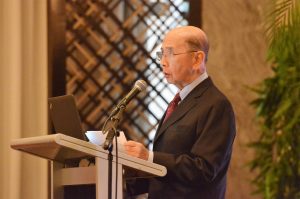Filipino Worldview – By Roberto R. Romulo: Huge step towards disaster resilience

The Philippine Star
August 3, 2018

US-Philippines Society Director Amb. Roberto R. Romulo at the Special Joint Meeting of members of the US-Philippines Society and Makati Business Club
President Duterte’s earnest call for Congress to pass a law creating a Department of Disaster Resilience during his 3rd State of the Nation Address (SONA) is hopefully the start of a serious effort to address our country’s inadequate disaster management capabilities. The President had made a similar call in his second SONA, although absent a detailed proposal to create a stand alone department.
This time around, the President said the Cabinet would submit its proposal for the creation of such a department. In addition to the Cabinet proposed legislation, I understand that there, in fact, are several bills in the House and in the Senate – with varying approaches to disaster risk reduction and resilience.
The Cabinet proposal seems to be the most comprehensive, even though I also have my reservations about some of its provisions. I do hope it responds pro-actively to meet the requirements of what the President said is “a truly empowered department characterized by a unity of command, science-based approach, and full-time focus on natural hazards and disasters, and the wherewithal to take charge of the disaster risk reduction, preparedness, and response, with better recovery and faster rehabilitation.” I also hope it will welcome and, in fact, facilitate critical contributions to risk reduction and resilience from the non-government sector, specifically, the private sector, academia, and civil society.
But whatever final version emerges, it is our fervent hope Congress will respond with extreme urgency to what we understand to be growing risk to climate change, natural and technological hazards, as well as, human-induced emergencies. According to media reports records from the House’s official website, it says the proposed Department of Disaster Resilience bills remain pending at the Committee on Government Reorganization since July 2016, which does not augur well.
By a fortuitous turn of events, the new Speaker of the House, former president Gloria Arroyo, is familiar with the issue and has taken the cudgel in moving this bill at this critical juncture. To show that she means business, one of her first act as Speaker was to convene a briefing for lawmakers with the National Disaster Risk Reduction and Management Council (NDRRMC) on Monday, July 30. During briefing, she announced her intention to create a House Committee on Disaster Resilience to tackle the bills seeking to create the Department of Disaster Resilience. With such forceful leadership, I am optimistic SGMA will be able to shepherd this bill through the House fairly quickly. The question now is how fast the Senate will move and how much gap will have to be bridged between their version of the bill. We anticipate that there will be attempts to produce a compromise bill and we hope that this will not be the cause of further delay.
Resiliency is key
As readers of this column are probably aware, the private sector has been active in promoting disaster resiliency. To paraphrase the UN Office for Disaster Reduction, resilience is defined as the ability of a system, community, or society exposed to natural disasters to resist, absorb, accommodate, adapt to, transform, and recover from the effects of that disaster. We wish to add to that definition by stating that any recovery from a disaster should be achieved in ways that enhance society’s capacity to respond to future risks. While resilience is our goal, transformation in terms of evidence-informed leadership, knowledge, competencies and skills is critical to achieving it. This type of transformative leadership must be achieved through multi-stakeholder partnerships at both national and local levels.
A number of resiliency endeavors are in place at various levels of government and with the involvement of the private sector. The need to align these endeavors led to the establishment of the National Resilience Council (NRC). The NRC is a science and technology based public-private partnership headed by the secretary of National Defense as the co-chair for government, together with Hans Sy of SM Prime Holdings as the co-chair for private sector. The vice-chairs are DILG Undersecretary Austere Panadero, Ed Chua of Makati Business Club, Fr. Jett Villarin and Ernie Garilao representing the government, business, and scientific community/academe and CSOs, respectively. Antonia Yulo-Loyzaga is the president and Malu Erni is the executive director.
Recognizing that local governments play a primary role in achieving resilience, the NRC engaged directly with partners in the the business community, the executive and legislative departments, academia and the civil society sector in order to seek demand-driven solutions that are innovative, science-based, and localized. To date, the NRC is working with eight local government units, namely: Bataan province, and the cities of Valenzuela, Naga, Iriga, Iloilo, Ormoc, Cagayan de Oro and Zamboanga in a three-year program that combines training in leadership and governance and science and technology. Each LGU has now organized its own Local Resilience Councils. The active participation of civil society groups such as urban poor associations and PBSP, the armed forces and, both private and public universities ensure that multi-stakeholder commitments to bouncing forward, instead of bouncing back to our historical states of exposure and vulnerability.
The NRC stands ready to support the new department in achieving a climate and disaster resilient Philippines.
Science and technology for information integration
While we cannot prevent an earthquake or a typhoon from occurring, or a volcano from erupting, science and technology – particularly information technology – can reduce exposure and risk. Early warnings via social media, damage estimation and risk-sensitive land use planning rely on some form of ground-based and remotely sensed data, analytical tools, and communications technology. What is badly needed, and what we hope will be at the core of the new department is a central platform for information integration incorporating data from all the relevant agencies. This platform should allow us to better understand risk, synoptically and locally, and make timely and informed decisions.
The advent of artificial intelligence (AI) has made it possible to predict outcomes of natural phenomena before they become disasters. For example, the Taipei City government now has the capability to predict specific areas in the city – down to particular streets – where flooding may occur and its magnitude using algorithms to data collected over time. In some states in the US crunching information from citizens, social media users, and on-the-ground aid workers over time during crises are used to help experts provide early warnings, ground-level location data, and real-time report verification. The new platform for information integration should facilitate these types of preparedness, prevention, and response actions.
The leadership of the new DDR must, therefore, be fully committed to utilize such technologies and be fully resourced to have access to them.




